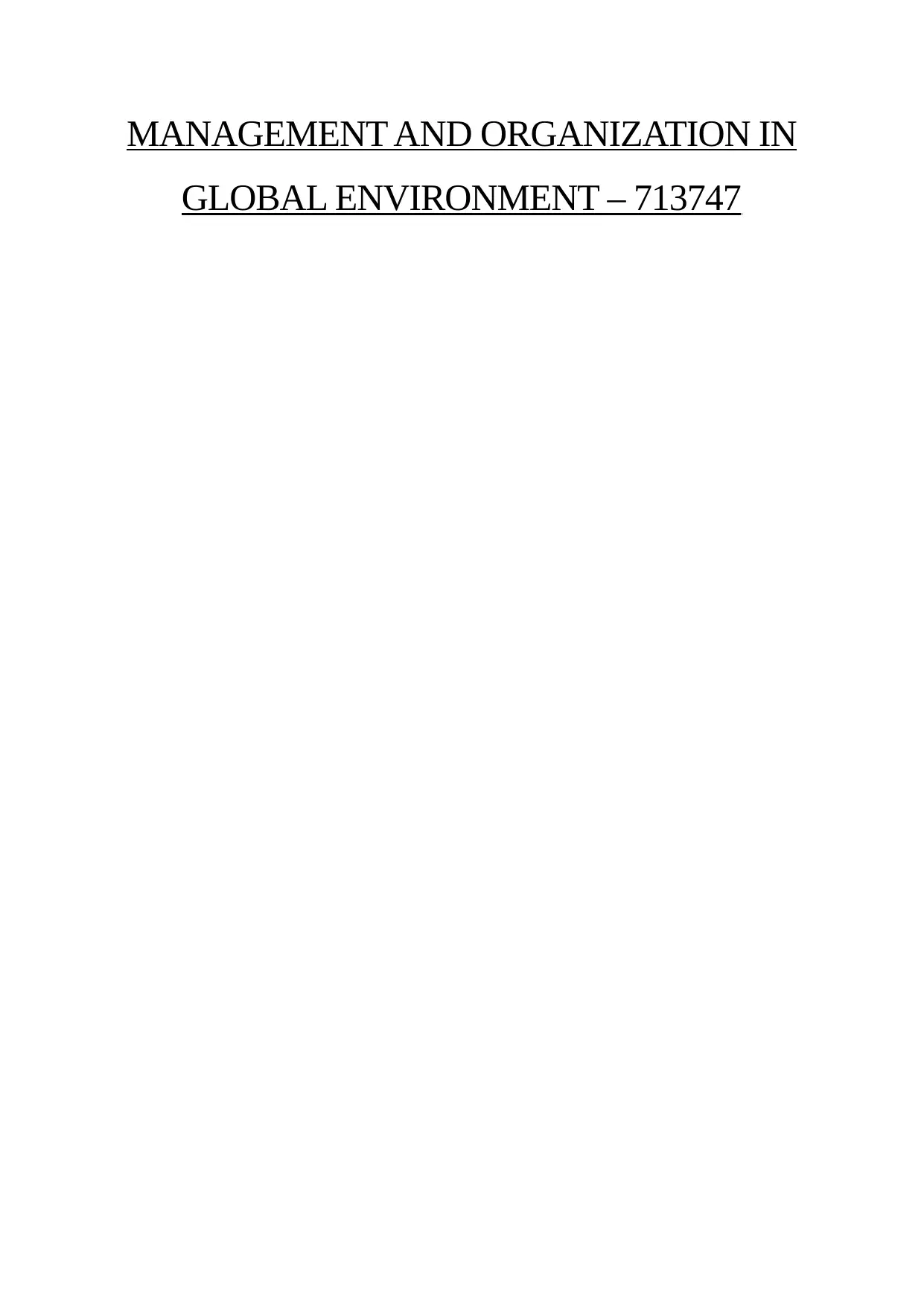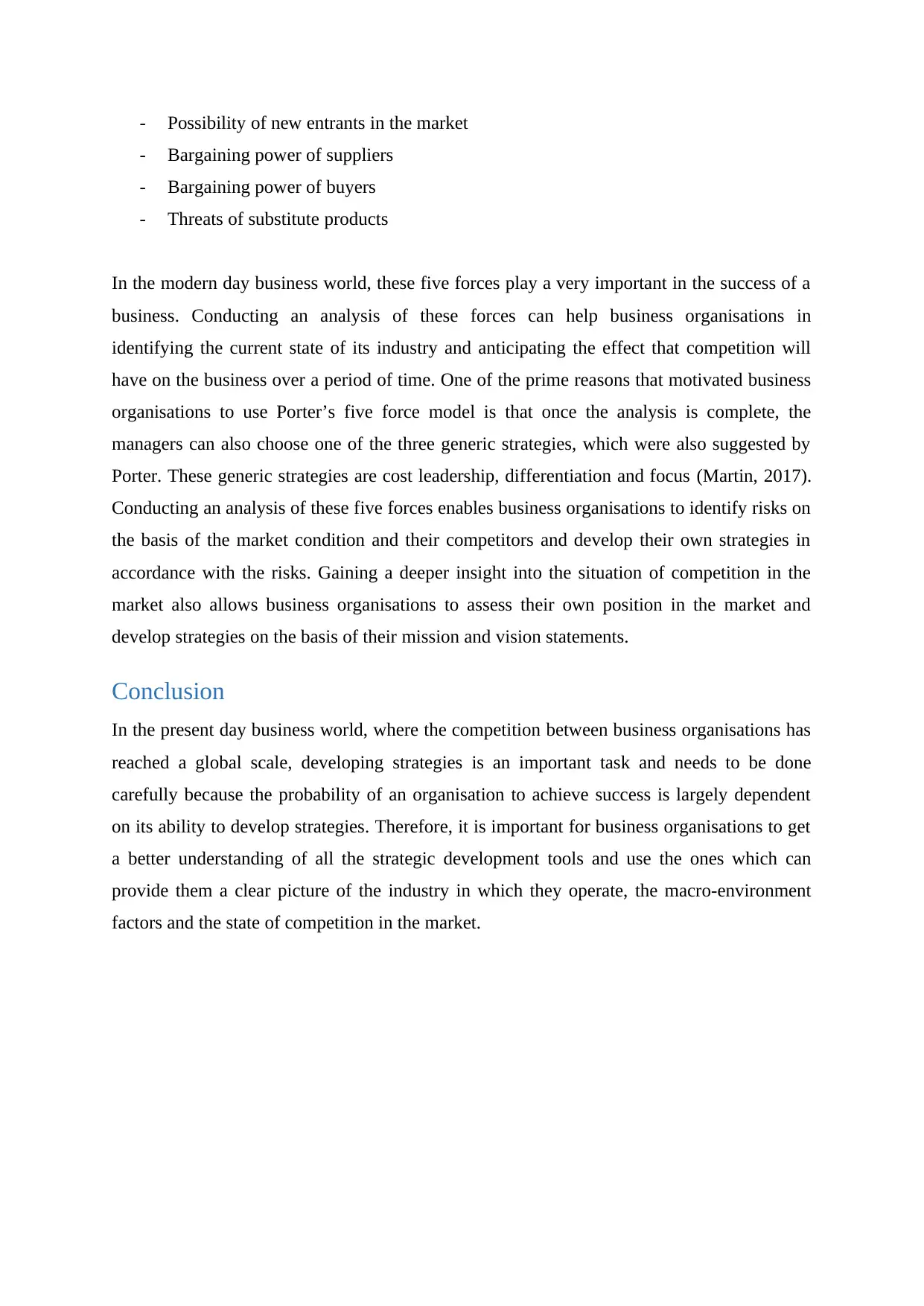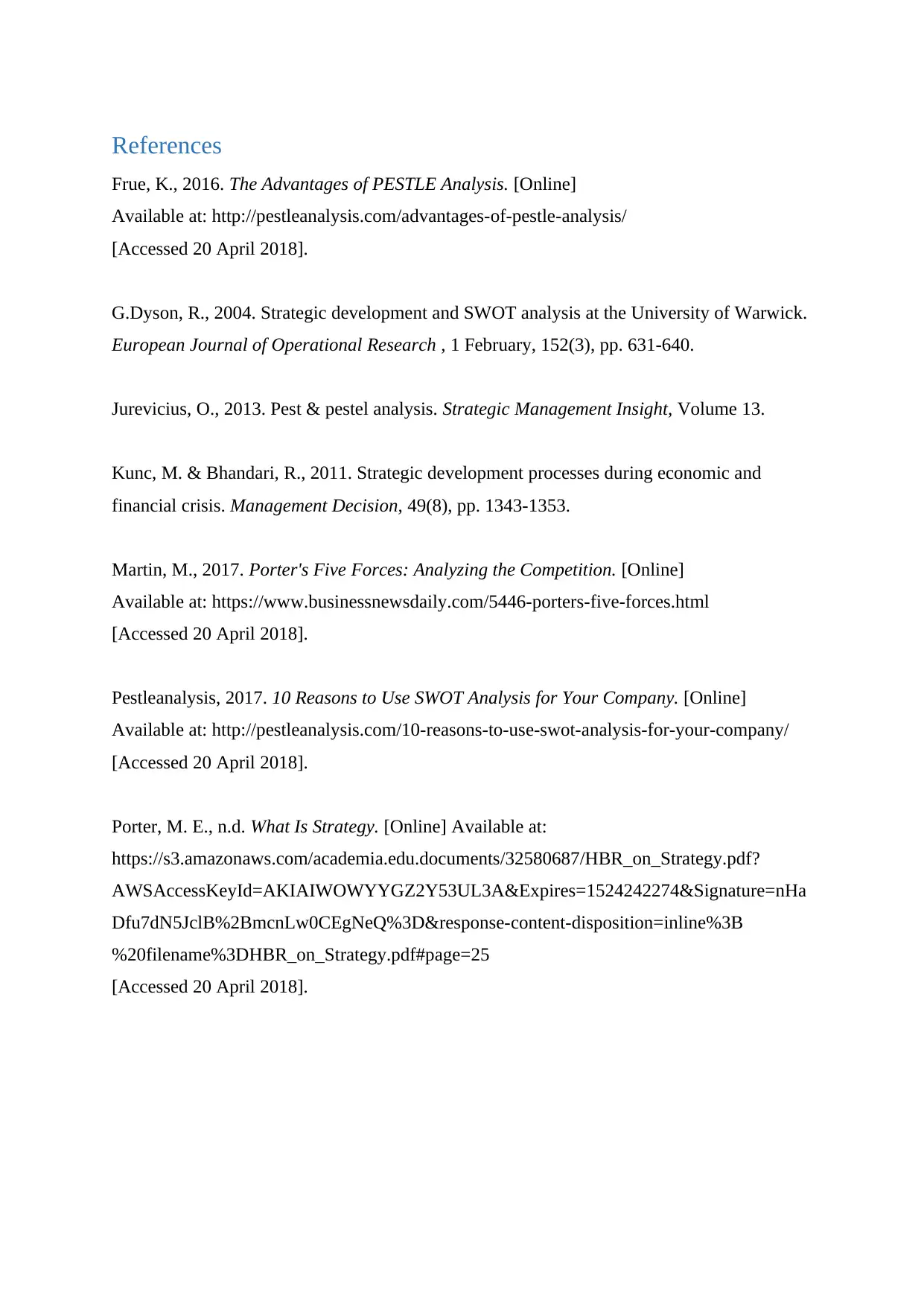HI6006 - Evaluating Strategy Development Tools in Global Management
VerifiedAdded on 2023/06/12
|6
|1328
|52
Essay
AI Summary
This essay provides a comprehensive overview of strategic development tools used in the business world, focusing on SWOT analysis, PESTEL analysis, and Porter's Five Forces model. It explains how these tools assist organizations in assessing their strategies, identifying internal and external factors affecting their business, and developing sustainable strategies to achieve their goals. The essay highlights the importance of understanding the industry, macro-environment, and competitive landscape for effective strategy development, emphasizing the role of these tools in helping businesses gain a competitive advantage in the global market.

MANAGEMENT AND ORGANIZATION IN
GLOBAL ENVIRONMENT – 713747
GLOBAL ENVIRONMENT – 713747
Paraphrase This Document
Need a fresh take? Get an instant paraphrase of this document with our AI Paraphraser

Table of Contents
Executive Summary............................................................................................................3
Strategic Development Tools..............................................................................................3
SWOT Analysis.............................................................................................................................3
PESTEL Analysis............................................................................................................................4
5F Model......................................................................................................................................4
Conclusion.........................................................................................................................5
References.........................................................................................................................6
Executive Summary............................................................................................................3
Strategic Development Tools..............................................................................................3
SWOT Analysis.............................................................................................................................3
PESTEL Analysis............................................................................................................................4
5F Model......................................................................................................................................4
Conclusion.........................................................................................................................5
References.........................................................................................................................6

Executive Summary
The business world is changing at a rapid pace, which is forcing business organisations to
continuously assess their existing strategies, develop new strategies and implement them in
the workplace, so that they can remain competitive. Formulating strong strategies that are
aligned with the mission and vision statement can help business organisations in achieving
their goals and objectives with ease. Therefore, business organisations use a number of
strategic development tools, in order to check the effectiveness of their existing strategies and
to develop new strategies, which would enable them to grab a greater share in the market.
This report has been prepared to gain a deeper insight into three strategic development tools.
Strategic Development Tools
Strategic development tools are methods or techniques that are used to analyse an
organisation’s strategy by assessing various factors that affect its business (Kunc & Bhandari,
2011). Some of the widely used strategic development tools are discussed below:
SWOT Analysis
SWOT Analysis, designed by Albert S. Humphrey in the 1960s, is the most widely used
strategic development tool throughout the world and is defined as Strengths, Weaknesses,
Opportunities and Threats. SWOT Analysis is prepared in a tabular form, i.e. in a 2*2 table
where strengths are written against weaknesses while the opportunities are listed against the
threats.
SWOT Analysis can help a company in assessing its internal as well as the external
environment because strengths and weaknesses are internal factors while opportunities and
threats are external factors that affect a company. Based on the results of a SWOT analysis, it
becomes easier for an organisation to develop a sustainable strategy in the market, which is
based on reliable and accurate information (G.Dyson, 2004). The usage of SWOT analysis
can vary from one organisation to another. Certain organisations use SWOT analysis as a tool
that helps them in kick starting the development of a strategy by analysing their internal
position and the prevailing market conditions whereas certain companies can use it in an
advance way to formulate important strategies that are imperative for the success of their
business. SWOT Analysis has also gained a lot of popularity amongst strategy developers
The business world is changing at a rapid pace, which is forcing business organisations to
continuously assess their existing strategies, develop new strategies and implement them in
the workplace, so that they can remain competitive. Formulating strong strategies that are
aligned with the mission and vision statement can help business organisations in achieving
their goals and objectives with ease. Therefore, business organisations use a number of
strategic development tools, in order to check the effectiveness of their existing strategies and
to develop new strategies, which would enable them to grab a greater share in the market.
This report has been prepared to gain a deeper insight into three strategic development tools.
Strategic Development Tools
Strategic development tools are methods or techniques that are used to analyse an
organisation’s strategy by assessing various factors that affect its business (Kunc & Bhandari,
2011). Some of the widely used strategic development tools are discussed below:
SWOT Analysis
SWOT Analysis, designed by Albert S. Humphrey in the 1960s, is the most widely used
strategic development tool throughout the world and is defined as Strengths, Weaknesses,
Opportunities and Threats. SWOT Analysis is prepared in a tabular form, i.e. in a 2*2 table
where strengths are written against weaknesses while the opportunities are listed against the
threats.
SWOT Analysis can help a company in assessing its internal as well as the external
environment because strengths and weaknesses are internal factors while opportunities and
threats are external factors that affect a company. Based on the results of a SWOT analysis, it
becomes easier for an organisation to develop a sustainable strategy in the market, which is
based on reliable and accurate information (G.Dyson, 2004). The usage of SWOT analysis
can vary from one organisation to another. Certain organisations use SWOT analysis as a tool
that helps them in kick starting the development of a strategy by analysing their internal
position and the prevailing market conditions whereas certain companies can use it in an
advance way to formulate important strategies that are imperative for the success of their
business. SWOT Analysis has also gained a lot of popularity amongst strategy developers
⊘ This is a preview!⊘
Do you want full access?
Subscribe today to unlock all pages.

Trusted by 1+ million students worldwide

because it can help business organisations in analysing the present state in which the business
is and the direction in which it is going to most likely develop (Pestleanalysis, 2017).
Therefore, the scope of usage of SWOT analysis for strategy development is practically
unlimited.
PESTEL Analysis
PESTEL or PESTLE, is another widely used tool for developing organisational strategies in
the present day business world. PESTEL analysis stands for political, economic, social,
technological, environmental and legal. Business organisations use PESTEL analysis to
analyse the macro-environment factors that have a direct impact on their business activities.
PESTEL analysis is widely used in the modern day world because it helps business
organisations in developing strategies by considering external forces. Business organisations
rely on PESTEL analysis for developing organisational strategies as it helps them in
identifying the threats and opportunities to their business and use them in conducting a
SWOT analysis to make their strategies more effective (Jurevicius, 2013). PESTEL analysis
has gained a lot of popularity in the business world because the only cost involved in
performing a PESTEL analysis is time. PESTEL analysis is also preferred by managers of
business organisations because developing an organisational strategy without considering the
external environment factors that affect a business can reduce the effectiveness of the strategy
and can result in the strategy failing altogether (Frue, 2016). Further, PESTEL analysis is
important for those business organisations that are operating in foreign countries as political,
social and economic factors of that particular region can have a great impact on their
strategies.
5F Model
5F model, also known as the Five Forces Model or Porter’s Five Forces Model, is another
commonly used method of strategy development, which is named after its founder – Michael
E. Porter (Porter, n.d.). In his analysis, Porter talked about the importance of analysing 5
forces that play an importance role in shaping the future of any market or industry in the
world. The five forces are:
- Competition in the industry
is and the direction in which it is going to most likely develop (Pestleanalysis, 2017).
Therefore, the scope of usage of SWOT analysis for strategy development is practically
unlimited.
PESTEL Analysis
PESTEL or PESTLE, is another widely used tool for developing organisational strategies in
the present day business world. PESTEL analysis stands for political, economic, social,
technological, environmental and legal. Business organisations use PESTEL analysis to
analyse the macro-environment factors that have a direct impact on their business activities.
PESTEL analysis is widely used in the modern day world because it helps business
organisations in developing strategies by considering external forces. Business organisations
rely on PESTEL analysis for developing organisational strategies as it helps them in
identifying the threats and opportunities to their business and use them in conducting a
SWOT analysis to make their strategies more effective (Jurevicius, 2013). PESTEL analysis
has gained a lot of popularity in the business world because the only cost involved in
performing a PESTEL analysis is time. PESTEL analysis is also preferred by managers of
business organisations because developing an organisational strategy without considering the
external environment factors that affect a business can reduce the effectiveness of the strategy
and can result in the strategy failing altogether (Frue, 2016). Further, PESTEL analysis is
important for those business organisations that are operating in foreign countries as political,
social and economic factors of that particular region can have a great impact on their
strategies.
5F Model
5F model, also known as the Five Forces Model or Porter’s Five Forces Model, is another
commonly used method of strategy development, which is named after its founder – Michael
E. Porter (Porter, n.d.). In his analysis, Porter talked about the importance of analysing 5
forces that play an importance role in shaping the future of any market or industry in the
world. The five forces are:
- Competition in the industry
Paraphrase This Document
Need a fresh take? Get an instant paraphrase of this document with our AI Paraphraser

- Possibility of new entrants in the market
- Bargaining power of suppliers
- Bargaining power of buyers
- Threats of substitute products
In the modern day business world, these five forces play a very important in the success of a
business. Conducting an analysis of these forces can help business organisations in
identifying the current state of its industry and anticipating the effect that competition will
have on the business over a period of time. One of the prime reasons that motivated business
organisations to use Porter’s five force model is that once the analysis is complete, the
managers can also choose one of the three generic strategies, which were also suggested by
Porter. These generic strategies are cost leadership, differentiation and focus (Martin, 2017).
Conducting an analysis of these five forces enables business organisations to identify risks on
the basis of the market condition and their competitors and develop their own strategies in
accordance with the risks. Gaining a deeper insight into the situation of competition in the
market also allows business organisations to assess their own position in the market and
develop strategies on the basis of their mission and vision statements.
Conclusion
In the present day business world, where the competition between business organisations has
reached a global scale, developing strategies is an important task and needs to be done
carefully because the probability of an organisation to achieve success is largely dependent
on its ability to develop strategies. Therefore, it is important for business organisations to get
a better understanding of all the strategic development tools and use the ones which can
provide them a clear picture of the industry in which they operate, the macro-environment
factors and the state of competition in the market.
- Bargaining power of suppliers
- Bargaining power of buyers
- Threats of substitute products
In the modern day business world, these five forces play a very important in the success of a
business. Conducting an analysis of these forces can help business organisations in
identifying the current state of its industry and anticipating the effect that competition will
have on the business over a period of time. One of the prime reasons that motivated business
organisations to use Porter’s five force model is that once the analysis is complete, the
managers can also choose one of the three generic strategies, which were also suggested by
Porter. These generic strategies are cost leadership, differentiation and focus (Martin, 2017).
Conducting an analysis of these five forces enables business organisations to identify risks on
the basis of the market condition and their competitors and develop their own strategies in
accordance with the risks. Gaining a deeper insight into the situation of competition in the
market also allows business organisations to assess their own position in the market and
develop strategies on the basis of their mission and vision statements.
Conclusion
In the present day business world, where the competition between business organisations has
reached a global scale, developing strategies is an important task and needs to be done
carefully because the probability of an organisation to achieve success is largely dependent
on its ability to develop strategies. Therefore, it is important for business organisations to get
a better understanding of all the strategic development tools and use the ones which can
provide them a clear picture of the industry in which they operate, the macro-environment
factors and the state of competition in the market.

References
Frue, K., 2016. The Advantages of PESTLE Analysis. [Online]
Available at: http://pestleanalysis.com/advantages-of-pestle-analysis/
[Accessed 20 April 2018].
G.Dyson, R., 2004. Strategic development and SWOT analysis at the University of Warwick.
European Journal of Operational Research , 1 February, 152(3), pp. 631-640.
Jurevicius, O., 2013. Pest & pestel analysis. Strategic Management Insight, Volume 13.
Kunc, M. & Bhandari, R., 2011. Strategic development processes during economic and
financial crisis. Management Decision, 49(8), pp. 1343-1353.
Martin, M., 2017. Porter's Five Forces: Analyzing the Competition. [Online]
Available at: https://www.businessnewsdaily.com/5446-porters-five-forces.html
[Accessed 20 April 2018].
Pestleanalysis, 2017. 10 Reasons to Use SWOT Analysis for Your Company. [Online]
Available at: http://pestleanalysis.com/10-reasons-to-use-swot-analysis-for-your-company/
[Accessed 20 April 2018].
Porter, M. E., n.d. What Is Strategy. [Online] Available at:
https://s3.amazonaws.com/academia.edu.documents/32580687/HBR_on_Strategy.pdf?
AWSAccessKeyId=AKIAIWOWYYGZ2Y53UL3A&Expires=1524242274&Signature=nHa
Dfu7dN5JclB%2BmcnLw0CEgNeQ%3D&response-content-disposition=inline%3B
%20filename%3DHBR_on_Strategy.pdf#page=25
[Accessed 20 April 2018].
Frue, K., 2016. The Advantages of PESTLE Analysis. [Online]
Available at: http://pestleanalysis.com/advantages-of-pestle-analysis/
[Accessed 20 April 2018].
G.Dyson, R., 2004. Strategic development and SWOT analysis at the University of Warwick.
European Journal of Operational Research , 1 February, 152(3), pp. 631-640.
Jurevicius, O., 2013. Pest & pestel analysis. Strategic Management Insight, Volume 13.
Kunc, M. & Bhandari, R., 2011. Strategic development processes during economic and
financial crisis. Management Decision, 49(8), pp. 1343-1353.
Martin, M., 2017. Porter's Five Forces: Analyzing the Competition. [Online]
Available at: https://www.businessnewsdaily.com/5446-porters-five-forces.html
[Accessed 20 April 2018].
Pestleanalysis, 2017. 10 Reasons to Use SWOT Analysis for Your Company. [Online]
Available at: http://pestleanalysis.com/10-reasons-to-use-swot-analysis-for-your-company/
[Accessed 20 April 2018].
Porter, M. E., n.d. What Is Strategy. [Online] Available at:
https://s3.amazonaws.com/academia.edu.documents/32580687/HBR_on_Strategy.pdf?
AWSAccessKeyId=AKIAIWOWYYGZ2Y53UL3A&Expires=1524242274&Signature=nHa
Dfu7dN5JclB%2BmcnLw0CEgNeQ%3D&response-content-disposition=inline%3B
%20filename%3DHBR_on_Strategy.pdf#page=25
[Accessed 20 April 2018].
⊘ This is a preview!⊘
Do you want full access?
Subscribe today to unlock all pages.

Trusted by 1+ million students worldwide
1 out of 6
Related Documents
Your All-in-One AI-Powered Toolkit for Academic Success.
+13062052269
info@desklib.com
Available 24*7 on WhatsApp / Email
![[object Object]](/_next/static/media/star-bottom.7253800d.svg)
Unlock your academic potential
Copyright © 2020–2025 A2Z Services. All Rights Reserved. Developed and managed by ZUCOL.





